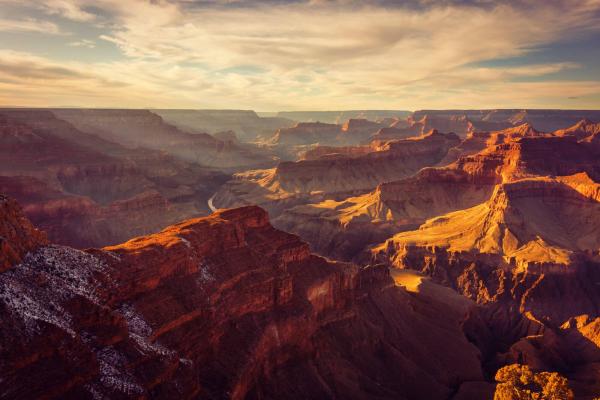NOTHING MAKES SENSE in the desert. Rocks that should be rock-colored sprout purple and pink under an impossibly blue sky. Barren cacti produce new blossoms. A wintry shade blisters in the sun. Canyon stone, having survived a billion years of harsh wind and water, crumbles in a human hand.
In a time when technology increasingly serves to nullify our bodies, the desert’s physicality obliterates the mind.
I’ve come to the Grand Canyon to remember that I still have a body, pitching camp in one of the last places on Earth where wireless data won’t reach. Simone Weil writes that prayer is an act of paying attention, and in the absence of overactive phone-brain, I’ll be sleeping outside for a week, listening to rivers and silence, kayaking along canyons, hiking through severe elevation, relying on basic survival instincts.
Halfway into the deep, the dehydrating grandeur of the canyon has completely overridden my brain. Thoughts are reduced to kinesthetic responses:
“Wow.”
“Stunning.”
“Ouch.”
“Drink more water, now.”
I’m relearning to pray with my body instead of my mind.
It’s disorienting to consider the soul knit to a fleshy animal, rather than paired with an enlightened brain. Early Christian gnostics believed our perfect souls were trapped in the decaying flesh of an evil physical world. Gnostics rejected the body, worshiping the mind as primary communicator with the soul.
Today, this elevation of the mind has returned in the philosophy of our most popular technologies. Our phones are increasingly acting as extensions of our brains, reminding us what we’ve learned, read, bought, and believed. Google, Twitter, and Facebook’s neural networks are accumulating the world’s data, automated beyond our individual brains.
For many tech pioneers, including Facebook’s Mark Zuckerberg, the ideal future for humanity is a constantly stimulated mind—virtual reality as the ultimate escape for our brains, away from the brutish limits of our bodies.
“We have always sought new ways of understanding ourselves out of conundrum we find ourselves [in],” writes Ethan Richardson. “Namely, that we are animals, too. That we get sick and we die.” In gnostic traditions, today’s transhumanism finds its creed: All mind, no body; all perfection; no risk or loss of control.
But the alien desert of the American Southwest has been a counterimaginarium for embodied futurists. Madeleine L’Engle wrote A Wrinkle in Time after a drive out West and came away describing the ultimate evil, “It,” as a gigantic, disembodied brain. It is not information that threatens humanity, she suggests, but a mind or soul divorced from its body. Risk the body, lose the soul.
This Christian understanding of humanity—that we are created as we are because we are loved, wholly and sinewy—reminds us to pray with our feet and remember that we have them.
God has placed eternity in the fleshy, beating hearts of humans. As we race toward the promise of virtual realities, I wonder what risks being lost in the infinite horizon.

Got something to say about what you're reading? We value your feedback!

